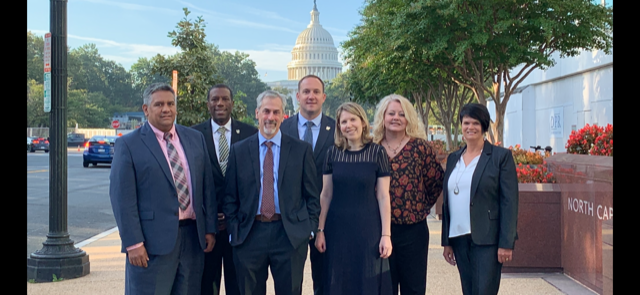
QUINTER — In March, a reporters from the Wall Street Journal and George Washington University, along with a film/photo crew from the Robert Wood Johnson Foundation visited Gove County. As part of their national study entitled “A New Portrait of Rural America,” Gove County represented “The Aging Farmland.”
This group traveled all spring throughout the United States, compiling data and stories about rural America. They presented their findings in their entirety on September 26 in Washington DC. Select community leaders from across rural America were asked to participate in a panel discussion as part of the event releasing the study.
Ericka Nicholson, Gove County economic development director, was invited and attended, expanding on the story of Gove County through a panel discussion and Q&A session following the study’s release.
The study was commissioned by the Robert Wood Johnson Foundation, with a purpose listed as follows: This is what American Communities Project (ACP) sets out to do. A combined social science/journalism effort based at The George Washington University’s School of Media & Public Affairs, the ACP uses a vast array of data – from election results and economic numbers to consumer survey and polling – to break communities into different types for analysis. The primary point: Even in the age of the Web, people in different places experience the world very differently.
Working with academics, the ACP used a wide range of different factors – everything from income to race and ethnicity to education to religious affiliation – and a clustering technique to identify 15 types of counties, everything from big cities to aging farmlands. It has mapped those types to show where the country’s political, socio-economic and cultural fissures are.
The result is an unprecedented growing attempt to understand the subtleties and complexities of the United States as the country reimagines its future and its place in the world. The project correlates economic and demographic data to election results and consumer data to see what is moving those different communities and to see who is struggling and who is thriving in the 21st Century United States.
The ACP’s 15 community types: African American South, Aging Farmlands, Big Cities, College Towns, Evangelical Hubs, Exurbs, Graying America, Hispanic Centers, LDS Enclaves, Middle Suburbs, Military Posts, Native American Lands, Rural Middle America, Urban Suburbs, and Working Class Country.
Highlighted in the Aging Farmland report is the surprising story of success found in healthcare delivery in Gove County.


Adding to the piece is a section about the advances in the Wheatland High School “hands on” educational offerings, and instructor (and local farmer) Mark Heier’s efforts to engage his students in these courses.
Also spotlighted is Gordon Jamison’s cattle and horse operation and how he has adapted his ranching business to evolve with the changing industry.

Kassie Remington (on behalf of Kansas Farm Bureau) contributes agricultural narrative to the piece as well as adding her own family’s farming and ranching business narrative.
Nicole Godek and Kay Haffner contribute to the report by discussing the founding and growth of the GCDC, and Godek ’s web based network of rural communities called Love Small Town America.
Nicholson’s contribution focuses on how many residents in very rural America must wear several hats, and reinvest in their communities.
“It was encouraging to see so many people filling the room who are genuinely interested in what is going on in very rural America,” she said.

“It is easy to tell the story of the people in our area and people are genuinely interested to hear that story. It is hopeful to me that so many are truly interested in this study of rural America. There were representatives there from the Wall Street Journal, Politico, NBC, HRSA, NACo, FDA, EPA, USDA and many more.
“I enjoyed meeting the other community leaders from this report. We all decided that while our struggles in rural America are similar, our tools, processes and methods of fighting for our communities are all very different,” Nicholson added.
To view the Entire American Communities Report you can visit https://www.americancommunities.org/.
To view the Gove County segment you can visit https://www.americancommunities.org/chapter/gove-county-kansas-aging-farmland/.
There is also a link to the televised event on the ACP webpage.
– SUBMITTED –
